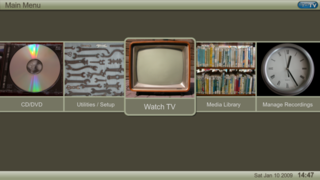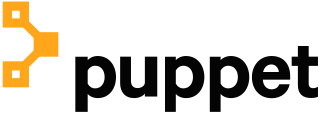
Client-server model is a distributed application structure that partitions tasks or workloads between the providers of a resource or service, called servers, and service requesters, called clients. Often clients and servers communicate over a computer network on separate hardware, but both client and server may reside in the same system. A server host runs one or more server programs, which share their resources with clients. A client usually does not share any of its resources, but it requests content or service from a server. Clients, therefore, initiate communication sessions with servers, which await incoming requests. Examples of computer applications that use the client-server model are email, network printing, and the World Wide Web.

A playlist is a list of video or audio files that can be played back on a media player either sequentially or in a shuffled order. In its most general form, an audio playlist is simply a list of songs, but sometimes a loop. The term has several specialized meanings in the realms of television broadcasting, radio broadcasting and personal computers.
In software engineering, the terms frontend and backend refer to the separation of concerns between the presentation layer (frontend), and the data access layer (backend) of a piece of software, or the physical infrastructure or hardware. In the client–server model, the client is usually considered the frontend and the server is usually considered the backend, even when some presentation work is actually done on the server itself.

MythTV is a free and open-source home entertainment application with a simplified "10-foot user interface" design for the living room TV. It turns a computer with the necessary hardware into a network streaming digital video recorder, a digital multimedia home entertainment system, or home theater personal computer. It can be considered a free and open-source alternative to TiVo or Windows Media Center. It runs on various operating systems, primarily Linux, macOS, and FreeBSD.

Broadcast automation incorporates the use of broadcast programming technology to automate broadcasting operations. Used either at a broadcast network, radio station or a television station, it can run a facility in the absence of a human operator. They can also run in a live assist mode when there are on-air personnel present at the master control, television studio or control room.
Music scheduling systems are employed to sequence music at radio stations. Although these systems were originally implemented by manual index card methods, since the late 1970s they have exploited the efficiency and speed of digital computers. They are essential tools for broadcasting by music radio stations.
Enterprise software, also known as enterprise application software (EAS), is computer software used to satisfy the needs of an organization rather than individual users. Such organizations include businesses, schools, interest-based user groups, clubs, charities, and governments. Enterprise software is an integral part of a (computer-based) information system; a collection of such software is called an enterprise system. These systems handle a chunk of operations in an organization to enhance the business and management reporting tasks. The systems must process the information at a relatively high speed and can be deployed across a variety of networks.

RCS, originally Radio Computing Services, is a provider of scheduling and broadcast software for radio, Internet and television stations.
In broadcasting, channel playout is the generation of the source signal of a radio or television channel produced by a broadcaster, coupled with the transmission of this signal for primary distribution or direct-to-audience distribution via any network. Such radio or television distribution networks include terrestrial broadcasting, cable networks, satellites, IPTV, OTT Video, point-to-point transport over managed networks or the public Internet, etc.
Almost all radio stations today use some form of broadcast automation. Although some only use small scripts in audio players, a more robust solution is using a full radio automation suite. There are many commercial and free radio automation packages available.
In broadcasting, rotation is the repeated airing of a limited playlist of songs on a radio station or satellite radio channel, or music videos on a TV network. They are usually in a different order each time. However, they are not completely shuffled, so as to avoid varying the time between any two consecutive plays of a given song by either too much or too little. When measuring airplay, the number of times a song is played is counted as spins.
A home server is a computing server located in a private computing residence providing services to other devices inside or outside the household through a home network or the Internet. Such services may include file and printer serving, media center serving, home automation control, web serving, web caching, file sharing and synchronization, video surveillance and digital video recorder, calendar and contact sharing and synchronization, account authentication, and backup services.
This is a comparison of notable free and open-source configuration management software, suitable for tasks like server configuration, orchestration and infrastructure as code typically performed by a system administrator.
LinuxMCE is a free and open source software platform with a 10-foot user interface designed to allow a computer to act as a home theater PC (HTPC) for the living-room TV, personal video recorder, and home automation system. It allows control of everything in the home, from lighting and climate to surveillance cameras and home security. It also includes a full-featured VoIP-compatible phone system with support for video conferencing.

In computing, Puppet is a software configuration management tool which includes its own declarative language to describe system configuration. It is a model-driven solution that requires limited programming knowledge to use.
Vinzant Software is a privately held company that is based in Hobart, IN. Vinzant Software develops and markets enterprise job scheduling products for platforms including Windows, Unix, Linux, IBM i and MPE/ix. It was founded in 1988 by David Vinzant and has solely focused on job scheduling since 1995.
Sysax FTP Automation is a Secure file transfer automation program for the Windows operating system. It consists of a script generation wizard, script editor and debugger, and a task scheduler. It also contains a secure command line FTP Client program called sysaxftp.exe that is a secure drop-in replacement for the ftp.exe command line program. In addition to FTP, secure file transfer using SSL/TLS (FTPS) and SSH2 (SFTP) are supported. The software is certified for Windows Vista, and tested to be compatible with Windows 7. The software is also certified for Windows Server 2012 and runs on all 32 and 64 bit editions of Windows from Windows 2000/Windows XP to Windows 8/Windows Server 2012. The Personal edition of the software is free for non-commercial use.

OpenBroadcaster is a web-based, open-source system to run community radio and television broadcast transmitters with a simple web interface.






